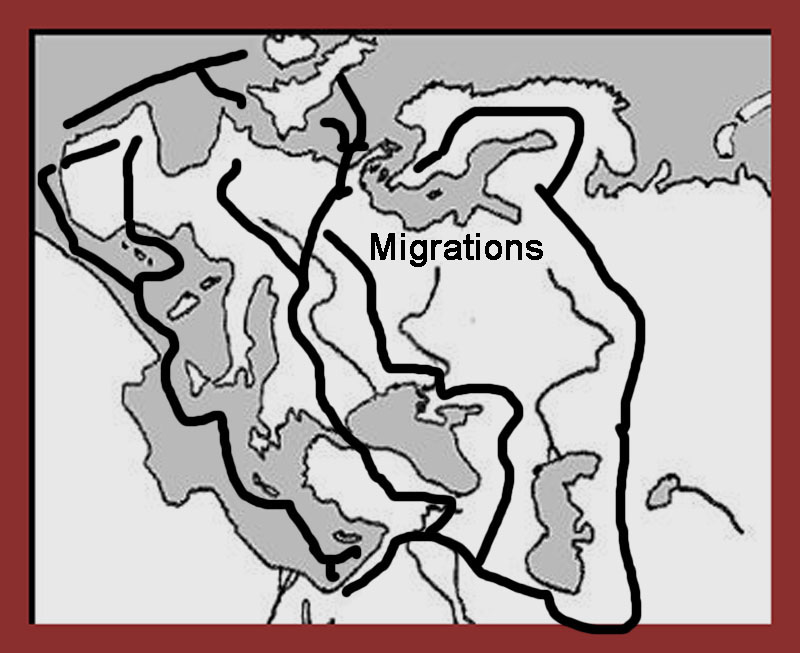Israelite Migrations to the West (15 March 2016, 5 Adar-B, 5776)
Summarized and Adapted from "The Tribes" chapter 3.

1. Movement by Sea
Most of the Israelites were exiled to the north. A portion however were transported overseas in Phoenician and Philistine ships working for the Assyrians (Amos 1:6-10).
Hebrews transported by ship were taken to Spain, Gaul, and Britain. Those taken to Spain later moved northward into Gaul or crossed over to Britain and Ireland.
Amos 4:2 should also more properly be translated as saying,
# The LORD GOD has sworn by His holiness: Behold, the days shall come upon you When He will take you away with large ships [tsinot], And your posterity with fish-boats. #
Fish-boats were a type of large ship known from Cyprus shaped like a fish.
Hebrews transported by ship were taken to Spain, Gaul, and Britain. Those taken to Spain later moved northward into Gaul or crossed over to Britain and Ireland. Proof for the transportation of Israelites to the West by Sea is obtainable from the Hebrew Bible, Biblical commentaries, traditions, legends, archaeology, and historical writings. The transportees merged with other Israelites who had moved overland and been influenced by Celtic civilization.
2. Movement by Land Northward
Ca.740-720 BCE: The Assyrians moved masses of Northern Israelites (and other Syrians and Phoenicians) to Northern Mesopotamia and to Hara in eastern Iran. They became identified with the Cimmerians, Scyths, and Goths.
3. Cimmerians to Europe and Galatian-Gaul
Ca. 640 BCE: The first waves of Cimmerians via Turkey and the Anatolian Bosporos were driven into Europe whence they made their way west to Gaul and Britain becoming known as Celts and Galatians.
4. First Scythian Movements to Europe
Ca. 550 BCE: The movement of Scythians from the Middle East to north of the Caucasus began in earnest with the penetration of Scythia.
5. Royal Scythians Move Westward
Climate changes in Scythia caused "Sarmatian" groups to push the Royal Scyths westward in the period 300-100 BCE. The Royal Scyths re-settled at first in the area of Bulgaria, then after renewed pressure continued north, ultimately to reach Scandinavia.
6. Royal Scythians to Scandinavia
The Huns emerging from Mongolia or further east (200-160 BCE) attacked the Aseir (Wusun), Goths, and Sacae and caused these peoples to war amongst themselves. These events were followed by a climate change which, after 120 BCE, caused the desolation of Chorasmia (east of the Caspian Sea) which previously had been heavily populated. Goths and Sacae began to move westward and Scandinavia was re-populated in the period 100 BCE-100 CE.
7.The Belgae
After 200 BCE the Belgae from the East began occupying Northern Gaul. They were associated with, or accompanied by, a group ultimately hailing from the Middle East and Syria and known linguistically as "The Northwest Block".
8. Eastern Scythians Move West
Later, from eastern Scythia, in the decades 70-50 BCE, the Western Sienbi and the Northern Hun group of Hugie, Dingling, and Gienkun moved westward. ...They began to re-appear from 50 BCE in the Rhine area of Western Europe and within a hundred years had taken over the region. ....The area of Germany, like Scandinavia, received Tribes coming from Scythia and about to continue westward into Gaul and Britain. ["Gaul" is a term generally inclusive of modern France, Belgium, Switzerland, and Holland].
9. Suebi and Saxons Move Westward
From 150-350 CE continuous warfare instigated by the Huns in East Scythia caused many more peoples to move westward amongst whom were the eastern branch of Sienbi in ca. 170 CE ....
The movements were of peoples coming from Scythia via Scandinavia and the Baltic Coast, and in the south via the Balkans. ....
The movement westward could also be quite sudden. Events on the borders of China or even deep within China sometimes had direct connection to movements in the west. Peoples of nomadic disposition would traverse the distance. Chain reactions of one group pushing forward another would also occur.
10.The Huns Push Saxons, Franks, and Others Westward In the years 350-450 CE the Huns moved en-masse out of "Scythia" (Eurasia) into Europe forcing most of the peoples in Scythia to accompany them or else to flee for their lives. As a result of the Hun invasions the Saxons, Franks, and Alamans received a large augmentation of manpower with the addition of new clans....
11. The Danites and Nephtalites Increase their Presence in Scandinavia
A good portion of the Naphtalite horde had remained to the east of Scythia. In the 450-500 CE period the Naphtalites began to move west eventually entering Scandinavia in the 500's and 600's CE. The Naphtalite horde included the Danes who re-settled Denmark possibly via Sweden.
12.The Viking Invasions
The continued migrations to Scandinavia resulted in over-population, the pushing outwards of coastal populations, and subsequent overseas colonization. The Scandinavians overseas were known as the Vikings. The Vikings settled in England, Scotland, Ireland, Normandy (France), and elsewhere.
13.The Normans
In Normandy the Vikings accepted French Culture and were called Normans. From Normandy they invaded England in 1066.
14. The Getae and Daci
A portion of the Cimmerian-host in its trip westward had remained in the Balkans and became known as the Getae and Dacii. ...Most of the Getae and Daci in the period 100 BCE-100 CE moved to the north toward the Baltic and Scandinavia and eventually participated in the Anglo-Saxon invasions of Britain.
15. The Picts and Khazars
Some groups of Sacae-related Israelites including bands of Goths and Naphtali remained in the Caucasus region and adjoining areas of Scythia. These were eventually to amalgamate with the Agathyrsi and form the KHAZAR nation which converted to Judaism.
16. The Movement to North America, Australia, etc.
Concerning the USA people came from all over the world especially Europe. Many of those from Europe emerged from social groups that had been relatively isolated. They constituted bodies that had remained relatively separate from the others and had different values and attitudes. These too were of Israelite Origin.
